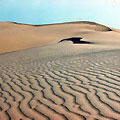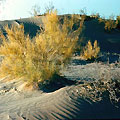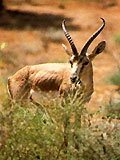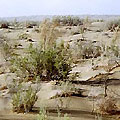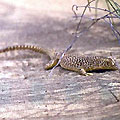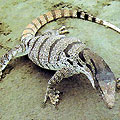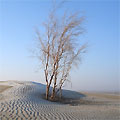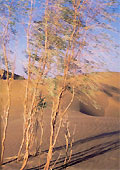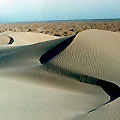Repetek Nature Reserve
Nature Reserves of Turkmenistan
The Repetek Nature Reserve is only a one hour journey (70km) from Turkmenabad; This sandy desert reservation, formed in 1912, it is located to the southwest of Turkmenabad, and is remarkable for its exhaustive information on the ancient nature of the Karakum desert and its climatic conditions.
There are large sand dunes, shifting sands and dry lake beds, attracting the attention of scientists to Repetek. The vegetation of Repetek is dominated by such small shrub species as saxaul (white and black), kandym, sand acacia and cherkez. The animal life of Repetek is also rich and diverse. There are almost 1.5 thousand species of invertebrates; including beetles, butterflies, spiders and other small creatures.
The Karakum desert only seems lifeless and dismal to one who has never been there. This is especially true in Repetek, one of the most interesting and thriving areas of the Karakum desert. The diversity of vegetation and animal life and magnificence of Repetek's landscapes captivates even the most experienced traveler. Not surprisingly, it was here that the first reserve in Turkmenistan was established almost eight decades ago. In 1979, at UNESCO's decision, the Repetek Reserve gained the status of "biosphere preserve" and thereby was inscribed in the list of internationally recognized models of natural ecosystems.
The unique nature of this region attracts many scientists' attention. Such eminent specialists as geneticist, Nikolai Ivanovich Vavilov, and the founder of contemporary soil science, Vasiliy Vasilyevich Dokuchaev, used to work in the Reserve. A Russian scientist and fiction writer, Vladimir Afanasyevich Obruchev, famous for his novels "The land of Sannikov" and "Plutonia" visited here, and dozens of other outstanding scientists and men of the arts stayed in the Reserve. Early last century, the famous geographer and traveler Pyotr Petrovich Semenov Tyan-Shanskiy was charmed by these places.
It couldn't be otherwise. Repetek is a place where in a relatively small area one can see practically all forms of the Karakum's sandy landscape which, by the way, are natural to other large and small deserts of the world. It turns out that the sandy landscape can be at times dune-like, ridge-like and hilly. It is impossible to enumerate all the possible variations. The part of the reserve carrying the appropriate name "Repetek Sahara" is particularly striking. Once you are there, you lose the feeling of reality. It is so engrossing. Dunes rise all around in quaintly stark waves, with their tops crowned by the thinnest yellow muslin - thousands of grains of sand disturbed by a gust of wind and stylishly lightened by bright sun rays. One can roam for hours in this fantastic realm of sand as if painted by an impressionist artist. No matter how big the dunes are, this is exactly the way the restless wind moves them from one place to another at its whim, sorting out these sand hills down to the last grain of sand. So, upon returning to this place, one may not recognize a seemingly well-known landscape.
It is truly amazing that connoisseurs can find their way out in this vast desert, not only among the moving sands, but in the wide-spread saxaul forests. The grove "Yaman tokay", located not far from the "Sahara", is one of them. Like in other groves, ordinary trees, relatively large but not very high grow here. However, under the canopy of these crowns you will not find any familiar forest shade. Instead of leaves, saxaul has delicate green twigs. Thanks to them, the tree can easily stand the heat of summer, which sometimes warms the sandy surface to 80 degrees Celsius. It is nothing but a natural oven, making it no accident that Repetek is ranked among the hottest places on the planet and called a "pole of heat". In the summer, it is scorching hot here!
Spring is quite different. This is a time when the desert sheds its winter numbness and takes on the splendid emerald hue. It doesn't look like a desert at this time of the year, but more like a blossoming garden. Bright red poppies and yellow flowers of gipecuum are scattered, as if by God's generous hand, in great number on the green carpet of sandy sedge, ilaka, under the canopy of the transparent saxaul forest. Tidy bushes of astragalus appear violet due to the abundance of flowers emitting an unforgettable fragrance. Delicate rosettes of fresh ferule, as if created by the skillful hands of lace-makers, are all around. Kandym bushes, full of yellow flowers that by summer turn to bright fluffy balls (the plant's fruit), grow here as well. Like many other desert plants, kandym has no leaves. Instead, it uses green twigs. The local rhubarb is quite a different matter, as its leaves sometimes grow to huge sizes, up to a meter and a half. Another amazing tree of the desert is the sandy silvery acacia, a slender 6-7 m high tree reminiscent of a weeping willow, but not green. It dares to grow among free-flowing dunes and is not afraid of being buried under the heavy of sand.
Scientists have discovered that the Karakum is the most reproductive desert on our planet. Interestingly, the higher the temperature is, as high as 50-60 degrees Celsius in this case, the more effective is the functioning of its ecosystem. The fact that almost four hundred species of mushrooms and lower and higher plants (more than half of the Karakum desert's vegetation) grow here attests to the richness of flora of the Repetek Reserve.
The animal life of Repetek is also amazingly resplendent. There are almost 1.5 thousand species of invertebrates; beetles, butterflies, spiders and other small creatures. Among them are those which have become invaluable for use in science. For instance, one of the local darkling beetles was so lucky as to take part in ... space travel. The astronaut beetle stood the test of flight, provided scientists with valuable information necessary for assessing the possibilities of long interplanetary expeditions. The poisonous insects of the Repetek deserve special attention. A small and seemingly ordinary spider, karakurt, with venom 8-10 times stronger than that of the cobra, has been determined to be the most dangerous insect in the world, as compared to menacing scorpion, phalanx and tarantula. Repetek is home to over 90 percent of the Karakum's species of birds, reptiles and mammals; over 250 species of vertebrate animals. Among the reptiles one can come across the tortoise, a living fortress; the sandy and big-eared toad and agama; and the gecko, a fan of night adventures. There is also the opportunity to become acquainted with dozens of snake species, almost half of the number of species inhabiting Turkmenistan. A pride of the reserve, the Central Asian cobra, a beautiful and noble snake, always warning careless travelers of its presence, is also among them.
When facing a cobra, as well as the phoorsa, it is necessary to be careful and observe the "rules of etiquette", for they are very poisonous. Repetek is also home to such "imposing" reptiles as the giant grey lizard, which by the way, it is the biggest lizard in the country. Taking into consideration its menacing appearance, it is deservingly called a "crocodile of the desert".
Over 200 species of birds can be seen in the very heart of the scorching Karakum. One surprising fact is that among them are waterfowl, attracted by reservoirs formed in the sandy quarries on the outskirts of Repetek. Such birds as saxaul jay, which is ideally adapted to the conditions of dry climates, cannot leave the desert. However, birds of prey are rightfully considered the most imposing and famous birds in Repetek. The golden eagle, one of the largest eagles in the world, has become the mascot of the Reserve. The saker falcon and long-legged buzzard also impress with their intimidating appearance. Watching the pigeon-size kestrel, a small but very deft hunter, is also interesting. Long-eared and horned owls become the masters of the skies at night.
Gnawing animals such as cheek-weeds, gophers, and jerboas are the most numerous among the mammals in Repetek. It is they who leave flowery patterns on the sand, restlessly recorded by environmental specialists.
The tolai hare, one of the typical inhabitants of the desert, is frequently spotted. There are also many predators such as wildcats and foxes - characters of fairy tales. A rare desert predator, the caracal (lynx), lives in the reserve too. It is an intelligent and shy animal. To see it in the desert is a great fortune. Gazelles and slender, long legged antelopes are some the rarest and most beautiful inhabitants of Repetek. In 2001, a special farm was set up to breed and raise the gazelles in the reserve.
The Repetek Reserve of the Ministry of Natural Protection of Turkmenistan is one of the numerous astonishing and wonderful natural corners of the Karakum, a land of bright sun, "golden" dunes and saxaul forests. This world-class desert has preserved its exceptional individuality and originality throughout history, in many respects due to the centuries-old ability of the Turkmen people to live in harmony with the nature of their native land.
Today these traditions are being revived and environmental scientists are concerned about preserving the virgin beauty of Repetek; we would like to believe that decades and centuries from now the journey to the fairytale Turkmen desert will still be a real discovery for each and every visitor.
